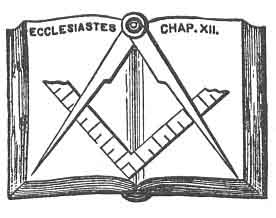“What does a Master’s lodge represent?”
Ans. “The Sanctum Sanctorum, or holy of holies of King Solomon’s Temple.”
“How long was the temple building?”
Ans. Seven years, during which it rained not in the day-time, that the workmen might not be obstructed in their labor.”
“What supported the temple.”
Ans. “Fourteen hundred and fifty-three columns and two thousand nine hundred and six pilasters, all hewn from the finest Parian marble.”
“What further supported it?”
Ans. “Three grand columns, or pillars.”
“What were they called?”
Ans. “Wisdom, strength and beauty.”
“What did they represent?”
Ans. “The pillar of wisdom represented Solomon, King of Israel, whose wisdom contrived the mighty fabric; the pillar of strength, Hiram, King of Tyre, who strengthened Solomon in his glorious undertaking; the pillar of beauty, Hiram Abiff, the widow’s son, whose cunning craft and curious
p. 99
workmanship beautified and adorned the temple.”
“How many were there employed in the building of King Solomon’s Temple?”
Ans. “Three Grand Masters, three thousand three hundred Masters, or overseers of the work, eighty thousand Fellow Crafts, and seventy thousand Entered Apprentices; all those were classed and arranged in such a manner by the wisdom of Solomon that neither envy, discord nor confusion were suffered to interrupt that universal peace and tranquillity that pervaded the work at that important period.”
“How many constitutes an Entered Apprentice lodge?”
Ans. “Seven; one Master and six Entered Apprentices.”
“Where did they usually meet?”
Ans. “On the ground floor of King Solomon’s Temple.”
“How many constitute a Fellow Craft’s lodge?”
Ans. “Five; two Masters and three Fellow Crafts.”
“Where did they usually meet?”
Ans. “In the middle chamber of King Solomon’s Temple.”
“How many constitute a Master’s lodge?”
Ans. “Three Master Masons.”
“Where did they usually meet?”
Ans. “In the Sanctum Sanctorum, or holy of holies of King Solomon’s Temple.”
“Have you any emblems on this degree?”
Ans. “We have several, which are divided into two classes.”
“What are the first class?”
Ans. “The pot of incense, the bee-hive, the book of constitutions, guarded by the Tyler’s sword, the sword pointing to a naked heart, the all-seeing eye, the anchor and ark, the forty-seventh problem of Euclid, the hour-glass, the scythe, and the three steps usually delineated on the Master’s carpet, which are thus explained: The pot of incense is an emblem of a pure heart, which is always an acceptable sacrifice to the Deity and, as this glows with fervent heat, so should our hearts continually glow with gratitude to the great and beneficent Author of our existence for the manifold blessings and comforts we enjoy. The bee-hive is an emblem of industry, and recommends the practice of that virtue to all created beings, from the highest seraph in heaven to the
p. 100
lowest reptile of the dust. It teaches us that, as we came into the world rational and intelligent beings, so we should ever be industrious ones, never sitting down contented while our fellow-creatures around us are in want, when it is in our power to relieve them without inconvenience to ourselves. When we take a survey of nature, we behold man, in his infancy, more helpless and indigent than the brute creation; he lies languishing for days, weeks, months and years, totally incapable of providing sustenance for himself; of guarding against the attacks of the wild beasts of the field, or sheltering himself from the inclemencies of the weather. It might have pleased the great Creator of heaven and earth to have made man independent of all other beings, but, as dependence is one of the strongest bonds of society, mankind were made dependent on each other for protection and security, as they thereby enjoy better opportunities of fulfilling the duties of reciprocal love and friendship. Thus was man formed for social and active life, the noblest part of the work of God, and he that will so demean himself, as not to be endeavoring to add to the common stock of knowledge and understanding, may be deemed a drone in the hive of nature, a useless member of society, and unworthy of our protection as Masons.
The book of constitutions, guarded by the Tyler’s sword, reminds us that we should be ever watchful and guarded in our thoughts, words, and actions, particularly when before the enemies of Masonry, ever bearing in remembrance those truly Masonic virtues, silence and circumspection. The sword pointing to a naked heart, demonstrates that justice will sooner or later overtake us; and although our thoughts, words and actions may be hidden from the eye of man yet that all-seeing eye, whom the sun, moon and stars obey, and under whose watchful care even comets perform their stupendous revolutions, pervades the inmost recesses of the human heart, and will reward us according to our merits. The anchor and ark, are emblems of a well grounded hope and a well spent life. They are emblematical of that Divine ark which safely wafts us over this tempestuous sea of troubles, and that anchor which shall safely moor us in a peaceful harbor, where the wicked cease from troubling, and the weary shall find rest.

Moe is the founder of GnosticWarrior.com. He is a father, husband, author, martial arts black belt, and an expert in Gnosticism, the occult, and esotericism.


